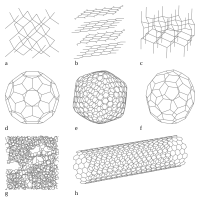
Photo from wikipedia
Abstract As new-generation carbon materials, carbon aerogels (CAs) offer opportunities in supercapacitor application owing to their excellent properties. Herein, we present a facile, green synthesis of CAs using glucose as… Click to show full abstract
Abstract As new-generation carbon materials, carbon aerogels (CAs) offer opportunities in supercapacitor application owing to their excellent properties. Herein, we present a facile, green synthesis of CAs using glucose as carbon source, one of the most important monosaccharide and abundant occurrence in the world, which can be readily available by plants photosynthesis and hydrolysis of disaccharide as well as polysaccharide. To improve the surface area and tailor the pore texture of the CAs, glucose as precursor was treated with an optional activating agent sodium hydroxide to obtain activated CA at 850 °C. SEM, TEM, XRD, XPS and Raman techniques reveal that the as-prepared CA-850 is of graphitized carbon layers and bimodal mesopores, possessing the high specific surface area of 2492.6 m 2 g −1 determined by BET characterization. Impressively, as electrode material for supercapacitors, CA-850 exhibits a high specific capacitance of 299 F g −1 , energy density of 41.52 Wh kg −1 as well as long-term cycling stability with 99% of the capacitance retention over 1000 cycles. This work will pave the way on the potential use of natural-abundance carbon source for green and mass production of carbon aerogels in supercapacitor applications.
Journal Title: Electrochimica Acta
Year Published: 2017
Link to full text (if available)
Share on Social Media: Sign Up to like & get
recommendations!